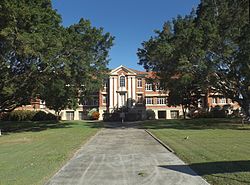
Brisbane Central Technical College is a heritage-listed technical college at 2 George Street, Brisbane City, City of Brisbane, Queensland, Australia. It was built from 1911 to 1956. It became the Queensland Institute of Technology (QIT) in 1965, and then in 1987 that became the Queensland University of Technology. It was added to the Queensland Heritage Register on 27 August 1999.

The Park Centre for Mental Health is a heritage-listed psychiatric hospital at 60 Grindle Road, Wacol, City of Brisbane, Queensland, Australia. It is one of the largest psychiatric hospitals in Australia. The hospital provides a range of mental health services, including extended inpatient care, mental health research, education and a high security psychiatric unit. It was designed by Kersey Cannan and built from 1866 to 1923. It is also known as Goodna Hospital for the Insane, Goodna Mental Hospital, Woogaroo Lunatic Asylum, and Wolston Park Hospital Complex. It was added to the Queensland Heritage Register on 21 October 1992.

West End State School is a heritage-listed state school at 24 Vulture Street, West End, City of Brisbane, Queensland, Australia. It was built from 1891 to 1960. It was added to the Queensland Heritage Register on 24 April 2018.

Windsor State School is a heritage-listed state school at 270 Lutwyche Road, Windsor, Queensland, Australia. It was built from 1915 to 1934. It is also known as Windsor Opportunity (Special) School and Windsor State School & Windsor Infants School. It was added to the Queensland Heritage Register on 1 August 1994.
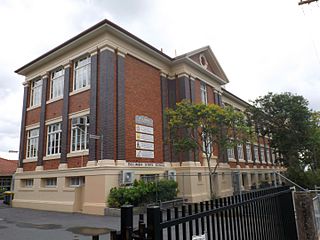
Bulimba State School is a heritage-listed state school at 261 Oxford Street, Bulimba, Queensland, Australia. It was built from 1915 to 1955. It was added to the Queensland Heritage Register on 26 November 1999.
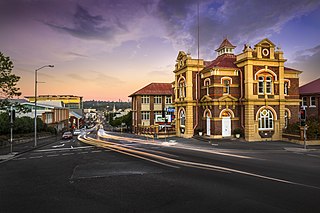
Queen Victoria Silver Jubilee Memorial Technical College is a heritage-listed technical college at 88 Limestone Street, Ipswich, City of Ipswich, Queensland, Australia. It was designed by architect George Brockwell Gill and built from 1897 to 1937. It is also known as Ipswich TAFE College and Ipswich Technical College. It was added to the Queensland Heritage Register on 21 October 1992.

Uniting Church Central Memorial Hall is a heritage-listed church hall at 86 East Street, Ipswich, City of Ipswich, Queensland, Australia. It was designed by George Brockwell Gill and built from 1895 to 1895 by W Betts. It is also known as Congregational Sunday School. It was added to the Queensland Heritage Register on 9 July 1993.

Townsville West State School is a heritage-listed former state school at 29 Ingham Road, West End, City of Townsville, Queensland, Australia. It was built from 1921 to 1939. It is also known as Townsville and District Education Centre and Memorial Gates. It was added to the Queensland Heritage Register on 5 October 1998.

Roma Government Complex is a heritage-listed former state school and now government offices at 42 Bungil Street, Roma, Maranoa Region, Queensland, Australia. It was designed by Department of Public Works (Queensland) and built in 1937. It was also known as Roma State School. It was added to the Queensland Heritage Register on 4 September 1998.

Brisbane Grammar School Buildings are a heritage-listed group of private school buildings of Brisbane Grammar School, 24 Gregory Terrace, Spring Hill, City of Brisbane, Queensland, Australia. They were added to the Queensland Heritage Register on 21 August 1992.
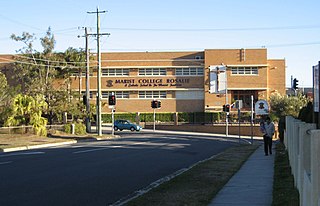
Marist Brothers College Rosalie Buildings are heritage-listed Roman Catholic monastery and school buildings at Fernberg Road, Rosalie, City of Brisbane, Queensland, Australia. They are also known as Marist Brothers' Monastery and Marist College. They were added to the Queensland Heritage Register on 18 September 2008.

New Farm State School is a heritage-listed state school on the corner of James & Heal Streets, New Farm, City of Brisbane, Queensland, Australia. It was designed by Department of Public Works (Queensland) and built from 1901 to 1939. It was added to the Queensland Heritage Register on 28 April 2017.

Milton State School is a heritage-listed state school at Bayswater Street, Milton, City of Brisbane, Queensland, Australia. It was built from 1923 to 1936 by Queensland Department of Public Works. It was added to the Queensland Heritage Register on 28 April 2017.

Ithaca Creek State School is a heritage-listed state school and war memorial at 49 Lugg Street, Bardon, City of Brisbane, Queensland, Australia. It was designed by Queensland Department of Public Work and built from 1930 to 1939. It was added to the Queensland Heritage Register on 5 February 2016.

Newmarket State School is a heritage-listed state school at 320 Enoggera Road, Newmarket, City of Brisbane, Queensland, Australia. It was designed by Queensland Department of Public Works and Boulton & Paul Ltd and built from 1910 to 1960. It was added to the Queensland Heritage Register on 5 February 2016.

Nundah State School is a heritage-listed state school at 41 Bage Street, Nundah, City of Brisbane, Queensland, Australia. It was built from 1892 to 1955. It was formerly known as German State National School and German Station State School. It was added to the Queensland Heritage Register on 15 July 2016.
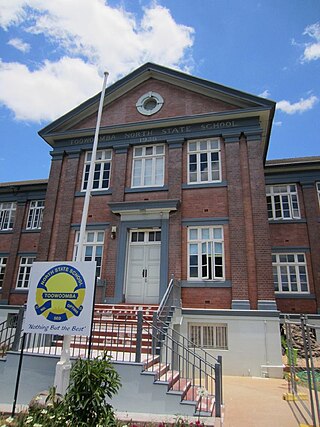
Toowoomba North State School is a heritage-listed state school at 139 Mort Street, Toowoomba City, Toowoomba, Toowoomba Region, Queensland, Australia. It was built from 1938 to 1957. It was formerly known as Mort Estate National School. It was added to the Queensland Heritage Register on 6 May 2016.

Indooroopilly State High School Buildings is a heritage-listed collection of buildings at Indooroopilly State High School at Ward Street, Indooroopilly, City of Brisbane, Queensland, Australia. It was designed by Boulton & Paul Ltd, Department of Public Works (Queensland) and built from 1953 to 1963. It was added to the Queensland Heritage Register on 14 October 2016.

Ashgrove State School is a heritage-listed state school at 31 Glory Street, Ashgrove, City of Brisbane, Queensland, Australia. It was designed by Andrew Baxter Leven, James Findlay Leven and Arthur James Edwin Moase. The Depression-era brick school building was built from 1938 to 1959. It was added to the Queensland Heritage Register on 24 April 2018.
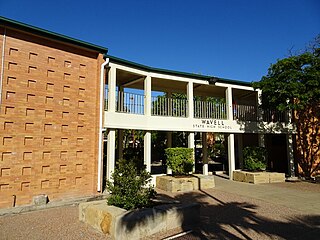
Wavell State High School buildings are a group of heritage-listed school buildings at Wavell State High School, Telopia Avenue, Wavell Heights, City of Brisbane, Queensland, Australia. They were designed by Department of Public Works (Queensland) and built from 1959 to 1966. They were added to the Queensland Heritage Register on 27 July 2018.
